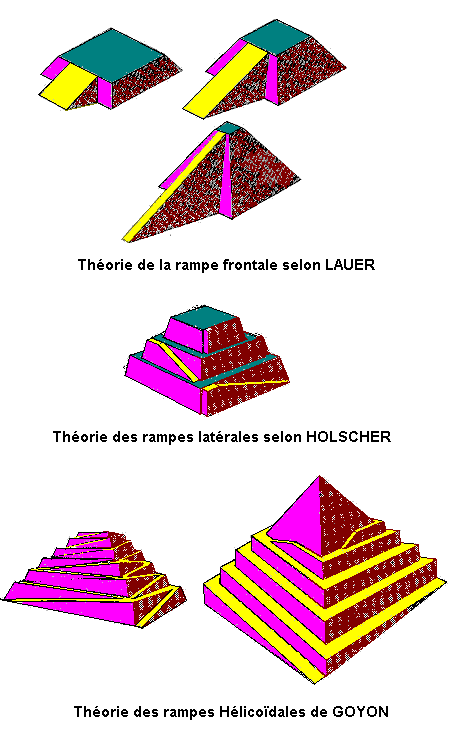ATTENTION!!
Ce site NE PEUT PAS fonctionner correctement car Javacript n'est pas activé sur votre navigateur.
(Menu ou diverses fonctions inactives...)
Pour informations,
Cliquez ici.
|

Vidéos
CLASSICAL BUILDING PROCESS ASSUMPTIONS
As of today, no proven answer exists to the question
of the pyramids building process,
and specially for the transport of stone blocks weighing
two tons or more. The only certitude is the proven use of
sledges, with skids, which induce the existence of ramps.
Click here for my own
assumption
One can find a proof of the use of sledges on a
bas-relief in the Geoutihotep tomb, in the el-Bersha
necropolis. (The use of a sledge on soil covered with
wet silt can reduce the apparent weight by a factor of ten).
The assumption of external ramps, straight or helicoidal,
(Lauer, Hôlsher, Goyon ... ramps) is very
unlikely because it induces huge embankments which would
have had to be demolished or moved away.
On the other hand, if we accept the assumption that no
ramp was used, then it would mean that the huge external
walls blocks were lifted bottom-up, level after level.
Although many stories since Herodote state the existence of
hoisting devices, is it possible to consider they can lift
the blocks from ground level to the top or rather consider
that they were used only for final setting and alignment ?
Last but not least, such ramps had
to sustain an important traffic with heavy loads:
thus they can be
mechanically stabilized if and only if they are either
very wide or if they are hold between higher shoulders.

LAUER front ramp theory, HOLSCHER side ramps
theory and GOYON helicoidal ramps theory
Examples below of
different block moving possibilities through sliding
techniques.

External ramp sliding, Side ramp sliding and
Internal ramp sliding
Only the third solution using internal ramps (or
shoulder hold) allows important mass transfers with all
compression efforts contained: this prevents both the risk
of collapsing or, on the other hand, the necessity of having
prohibitively wide sliding surfaces.
This is the main reason why I don't think that any of
Lauer's, Hôlsher's or Goyon's technique could have
been used, at least for the overall construction.
Below the principle of "the oarsmen technique" which enable to relocate 2,5 tons blocks with only a
pressure of 30kgs for levers of 2,50meters length with a 50 centimerers fulcum point. (A child astride at theend
of lever could do it).

Click here
for my own assumption

|

|

|
| Welcome |
Page Previous |
Top |
Site optimized for 1024 x 768 pixels.
Copyright© C. & M.Sélaudoux 2003-2024
|
|